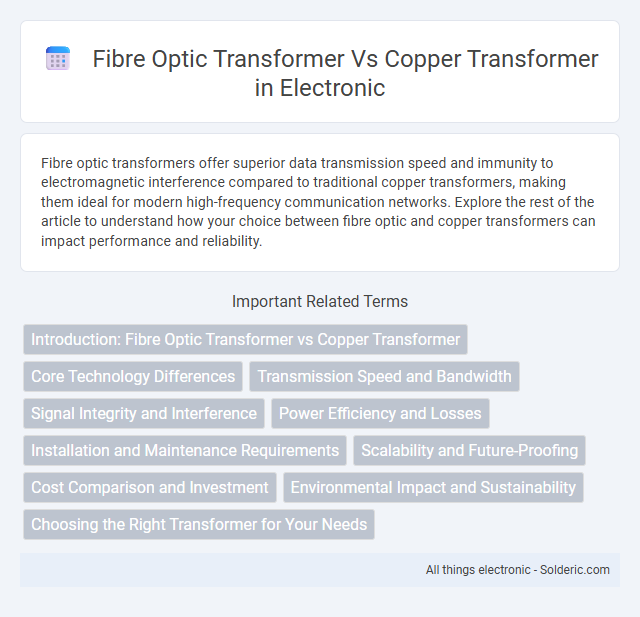Fibre optic transformers offer superior data transmission speed and immunity to electromagnetic interference compared to traditional copper transformers, making them ideal for modern high-frequency communication networks. Explore the rest of the article to understand how your choice between fibre optic and copper transformers can impact performance and reliability.
Comparison Table
| Feature | Fibre Optic Transformer | Copper Transformer |
|---|---|---|
| Core Material | Glass or plastic optical fibers | Copper windings |
| Signal Transmission | Light signals via fiber optics | Electrical signals via copper conductors |
| Power Loss | Minimal attenuation over long distances | Higher resistive losses |
| Weight | Lightweight | Heavier due to copper |
| Immunity to EMI | High immunity to electromagnetic interference | Susceptible to electromagnetic interference |
| Bandwidth | High bandwidth capacity | Limited bandwidth |
| Cost | Higher initial cost | Lower initial cost |
| Durability | Fragile fibers, careful handling required | Robust and durable |
| Applications | High-speed data transmission, telecommunications | Power distribution, general electrical transformers |
Introduction: Fibre Optic Transformer vs Copper Transformer
Fibre optic transformers utilize optical fibers to transmit electrical signals with minimal loss and electromagnetic interference, offering superior performance in high-frequency and long-distance applications compared to traditional copper transformers. Copper transformers rely on copper windings for electromagnetic induction, which can result in higher energy losses and susceptibility to external interference. Innovations in fibre optic technology enhance transformer efficiency, reliability, and signal integrity, especially in modern power and communication systems.
Core Technology Differences
Fibre optic transformers utilize optical fibers to transmit signals using light pulses, offering superior bandwidth, minimal signal loss, and electromagnetic interference immunity compared to copper transformers. Copper transformers rely on metal coils and magnetic induction to transfer electrical energy, which can be affected by resistance and electromagnetic noise, limiting efficiency and data integrity. Your choice depends on whether you prioritize high-speed data transmission and enhanced signal quality or traditional power distribution with established infrastructure.
Transmission Speed and Bandwidth
Fiber optic transformers offer significantly higher transmission speeds and greater bandwidth compared to copper transformers, enabling faster data transfer and supporting expansive network demands. Optical fibers can carry signals over longer distances with minimal signal loss and electromagnetic interference, ensuring consistent, high-quality performance. Your network infrastructure benefits from the superior capacity and reliability of fiber optic technology, especially in high-speed data communication applications.
Signal Integrity and Interference
Fiber optic transformers provide superior signal integrity by transmitting data through light pulses, which are immune to electromagnetic interference (EMI) and radio frequency interference (RFI), unlike copper transformers that rely on electrical signals susceptible to noise and signal degradation. The inherent immunity of fiber optics to external interference enhances data accuracy and reduces error rates in high-frequency or long-distance transmissions. Copper transformers, while cost-effective, often require additional shielding and grounding measures to maintain signal quality in electrically noisy environments.
Power Efficiency and Losses
Fiber optic transformers demonstrate superior power efficiency compared to copper transformers due to minimal resistive losses and enhanced signal integrity in data transmission. Copper transformers typically experience higher energy losses caused by electrical resistance and eddy currents, resulting in decreased overall efficiency. The reduced power losses in fiber optic transformers contribute to improved operational performance and lower energy consumption in electrical distribution systems.
Installation and Maintenance Requirements
Fibre optic transformers offer simplified installation with reduced wiring complexity and minimal electromagnetic interference, enhancing system reliability in challenging environments. Their maintenance demands are lower due to fewer mechanical parts and resistance to corrosion, contrasting with copper transformers that require regular inspection for overheating, insulation degradation, and physical wear. This leads to decreased downtime and operational costs when deploying fibre optic transformers in network infrastructure.
Scalability and Future-Proofing
Fibre optic transformers offer superior scalability by supporting higher data rates and longer transmission distances without signal degradation, making them ideal for evolving network demands. Copper transformers, limited by bandwidth and susceptibility to electromagnetic interference, often require costly upgrades to accommodate increased capacity. Your infrastructure benefits from fibre optics' future-proofing capabilities by enabling seamless integration with advanced technologies and expanding communication needs.
Cost Comparison and Investment
Fibre optic transformers typically require a higher initial investment compared to copper transformers due to the advanced technology and materials involved, yet they offer lower long-term maintenance costs and improved durability. Copper transformers usually have lower upfront costs but may incur greater expenses over time because of wear, corrosion, and energy losses. Evaluating your specific application and lifespan requirements is essential to determine the most cost-effective investment between these two transformer types.
Environmental Impact and Sustainability
Fibre optic transformers significantly reduce environmental impact compared to copper transformers by minimizing energy losses and lowering greenhouse gas emissions during operation. The sustainable nature of fibre materials, which are often recyclable and require less mining and extraction, further enhances their eco-friendliness. Your choice of fibre optic technology supports long-term sustainability efforts by promoting energy efficiency and reducing resource depletion.
Choosing the Right Transformer for Your Needs
Fibre optic transformers offer superior electromagnetic interference resistance and enhanced signal clarity compared to traditional copper transformers, making them ideal for high-speed data transmission and sensitive electronic applications. Copper transformers excel in cost-effectiveness and robustness, providing reliable performance in general electrical power distribution and low-frequency environments. Understanding the specific demands of your application, such as signal integrity and environmental conditions, ensures you select the right transformer for your needs.
fibre optic transformer vs copper transformer Infographic

 solderic.com
solderic.com